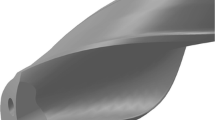Abstract
This paper focuses on the impact of cryogenic assistance on the drilling of Ti6Al4V titanium alloy. It develops a relation between the phenomenon of hole shrinkage and measurements performed either during or after the machining operation. Indeed, because this phenomenon is apparently strongly associated with heat generation, which is the main issue in titanium alloy drilling, this work proposes to verify the effect of liquid nitrogen cooling on hole shrinkage, quantify it, and then relate it to these measurements. Specifically, the cutting forces and final hole geometry are analyzed and their variations are explained using the collected data on hole shrinkage.














Similar content being viewed by others
References
Donachie MJ (1988) Titanium: a technical guide. ASM International
Ghani JA, Che Haron CH, Hamdan SH, Md Said AY, Tomadi SH (2013) Failure mode analysis of carbide cutting tools used for machining titanium alloy. Ceram Int 39:4449–4456. https://doi.org/10.1016/j.ceramint.2012.11.038
Ramirez C, Idhil Ismail A, Gendarme C, Dehmas M, Aeby-Gautier E, Poulachon G, Rossi F (2017) Understanding the diffusion wear mechanisms of WC-10%Co carbide tools during dry machining of titanium alloys. Wear 390–391:61–70. https://doi.org/10.1016/j.wear.2017.07.003
Cantero JL, Tardío MM, Canteli JA, Marcos M, Miguélez MH (2005) Dry drilling of alloy Ti–6Al–4V. Int J Mach Tools Manuf 45:1246–1255. https://doi.org/10.1016/j.ijmachtools.2005.01.010
Dornfeld DA, Kim JS, Dechow H, Hewson J, Chen LJ (1999) Drilling Burr formation in titanium alloy, Ti-6AI-4V. CIRP Ann - Manuf Technol 48:73–76. https://doi.org/10.1016/S0007-8506(07)63134-5
Kalidas S, Kapoor SG, DeVor RE (2002) Influence of thermal effects on hole quality in dry drilling, part 1: a thermal model of workpiece temperatures. J Manuf Sci Eng 124:258–266. https://doi.org/10.1115/1.1455645
Hong SY, Ding Y (2001) Cooling approaches and cutting temperatures in cryogenic machining of Ti-6Al-4V. Int J Mach Tools Manuf 41:1417–1437. https://doi.org/10.1016/S0890-6955(01)00026-8
Dhananchezian M, Pradeep Kumar M (2011) Cryogenic turning of the Ti–6Al–4V alloy with modified cutting tool inserts. Cryogenics 51:34–40. https://doi.org/10.1016/j.cryogenics.2010.10.011
Kaynak Y, Gharibi A, Ozkutuk M (2018) Experimental and numerical study of chip formation in orthogonal cutting of Ti-5553 alloy: the influence of cryogenic, MQL, and high pressure coolant supply. Int J Adv Manuf Technol 94:1411–1428. https://doi.org/10.1007/s00170-017-0904-y
Venugopal KA, Paul S, Chattopadhyay AB (2007) Tool wear in cryogenic turning of Ti-6Al-4V alloy. Cryogenics 47:12–18. https://doi.org/10.1016/j.cryogenics.2006.08.011
Rotella G, Dillon OW, Umbrello D, Settineri L, Jawahir IS (2014) The effects of cooling conditions on surface integrity in machining of Ti6Al4V alloy. Int J Adv Manuf Technol 71:47–55. https://doi.org/10.1007/s00170-013-5477-9
Kim DY, Kim DM, Park HW (2018) Predictive cutting force model for a cryogenic machining process incorporating the phase transformation of Ti-6Al-4V. Int J Adv Manuf Technol 1–12:1293–1304. https://doi.org/10.1007/s00170-018-1606-9
Pu Z, Outeiro JC, Batista AC, Dillon OW, Puleo DA, Jawahir IS (2012) Enhanced surface integrity of AZ31B Mg alloy by cryogenic machining towards improved functional performance of machined components. Int J Mach Tools Manuf 56:17–27. https://doi.org/10.1016/j.ijmachtools.2011.12.006
Pusavec F, Hamdi H, Kopac J, Jawahir IS (2011) Surface integrity in cryogenic machining of nickel based alloy Inconel 718. J Mater Process Technol 211:773–783. https://doi.org/10.1016/j.jmatprotec.2010.12.013
Biček M, Dumont F, Courbon C, Pušavec F, Rech J, Kopač J (2012) Cryogenic machining as an alternative turning process of normalized and hardened AISI 52100 bearing steel. J Mater Process Technol 212:2609–2618. https://doi.org/10.1016/j.jmatprotec.2012.07.022
Hong SY, Ding Y, Jeong W (2001) Friction and cutting forces in cryogenic machining of Ti–6Al–4V. Int J Mach Tools Manuf 41:2271–2285. https://doi.org/10.1016/S0890-6955(01)00029-3
Bermingham MJ, Kirsch J, Sun S, Palanisamy S, Dargusch MS (2011) New observations on tool life, cutting forces and chip morphology in cryogenic machining Ti-6Al-4V. Int J Mach Tools Manuf 51:500–511. https://doi.org/10.1016/j.ijmachtools.2011.02.009
Merzouki J, Poulachon G, Rossi F, Ayed Y, Abrivard G (2017) Method of hole shrinkage radial forces measurement in Ti6Al4V drilling. Procedia CIRP, 16th CIRP conference on Modelling of machining operations (16th CIRP CMMO) 58:629–634. https://doi.org/10.1016/j.procir.2017.03.226
Li R, Riester L, Watkins T, Blau P, Shih A (2007) Metallurgical analysis and nanoindentation characterization of Ti–6Al–4V workpiece and chips in high-throughput drilling. Mater Sci Eng A 472:115–124. https://doi.org/10.1016/j.msea.2007.03.054
Yagishita H, Morita Y (2018) Effect of phase transformation upon hole making accuracy of Ti6Al4V by orbital drilling. Procedia Manuf 26:152–163. https://doi.org/10.1016/j.promfg.2018.07.022
Bono M, Ni J (2001) The effects of thermal distortions on the diameter and cylindricity of dry drilled holes. Int J Mach Tools Manuf 41:2261–2270. https://doi.org/10.1016/S0890-6955(01)00047-5
Bonnet C (2010) Compréhension des mécanismes de coupe lors du perçage à sec de l’empilage Ti6Al4V/Composite fibre de carbone. Dissertation, Arts et Métiers ParisTech
Nobre JP, Outeiro JC (2015) Evaluating residual stresses induced by drilling of Ti-6Al-4V alloy by using an experimental-numerical methodology. Procedia CIRP, 15th CIRP conference on modelling of machining operations (15th CMMO) 31:215–220. https://doi.org/10.1016/j.procir.2015.03.062
Acknowledgments
The Ti6Al4V plates, nitrogen storage/delivery equipment, and machining tools used to perform the drilling tests were supplied by AIRBUS, AIR LIQUIDE, and ISCAR, respectively. Their support is gratefully acknowledged by the authors.
Author information
Authors and Affiliations
Corresponding author
Additional information
Publisher’s note
Springer Nature remains neutral with regard to jurisdictional claims in published maps and institutional affiliations.
Rights and permissions
About this article
Cite this article
Merzouki, J., Poulachon, G., Rossi, F. et al. Effect of cryogenic assistance on hole shrinkage during Ti6Al4V drilling. Int J Adv Manuf Technol 108, 2675–2686 (2020). https://doi.org/10.1007/s00170-020-05381-z
Received:
Accepted:
Published:
Issue Date:
DOI: https://doi.org/10.1007/s00170-020-05381-z




